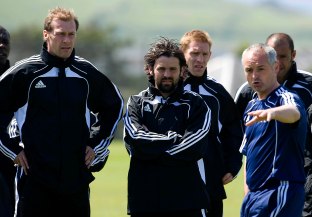In an exclusive blog from the UEFA Pro Licence visit to the FIFA Under-20 World Cup in Turkey, Everton coach Duncan Ferguson discusses iPads, PowerPoint presentations and the humble pen and paper on his coaching journey.
This week was a first for me: my first PowerPoint presentation in front of a group of fellow coaches here in Turkey. I don’t usually get nervous in football but equally I’m not up to speed with the latest technology so it is something that I have had to work hard at. It is where the game is heading now though – we are in the digital age – and it is something I want to improve on, and will improve on.
The guys are here with their iPads and laptops but I’m old-fashioned: I’m still a pen and paper guy, but I see enough dug-out shots on television to know there is room for both methods in football.
Talking in public doesn’t faze me. I do it on a regular basis at Everton but with different people with different backgrounds it can get uncomfortable. I suppose that is part of the learning experience on this course. It is a good way to get to know each other but also to stretch yourself as a person and a coach.
My remit this week was to analyse Chile’s defensive shape against Egypt. It can be a help being a former centre forward because a lot of my career was spent identifying and exploiting the weaknesses and deficiencies of defenders but the beauty of coaching is realising that defensive shape is not just confined to defenders but also strikers in how they close down, midfielders in how they screen and even how a goalkeeper wants his defenders positioned.

There are so many elements to consider: do they keep a high line or low line? How do they shape up at set-pieces and what are the responsibilities of each player? Do they go man-for-man at the back? Do they play out of defence or do they play a more direct game? Do they show players outside or inside? Once you analyse all of the defensive elements you have to examine their strengths and weaknesses individually and collectively.
I was in a group with Paul Williams of Southampton, Gavin Strachan, Ricky Sbragia and Barry Smith but watching the game was only the first challenge. Since everyone had their own part of the game to assess we then had to collate everybody’s work so we had an overview of the whole game. It then had to be distilled into a PowerPoint presentation and so by the time we got back from the game to the hotel, got all our notes collated and put into a presentable format it was half three in the morning. We started at 8am!
I’m usually a good sleeper, even ahead of big games as a player, but I have to say my mind was racing the whole night at the thought of presenting. Watching two games back-to-back, analysing one of them, then piecing together a presentation is mentally draining.
Once we presented the following morning – which went really well, incidentally – we then had to go out on to the pitch and discuss the strengths and weaknesses of both teams and, crucially, what we would do as coaches to prevent certain situations arising.
The balance of analysis, presentation and then going back out to the training ground to review and give your own interpretation shows the attention to detail. The fact that so many people want to come on the course shows how well respected it is. I am loving being back in the game and I think the time out allowed me time to look at the game a different way; watching lots of different teams, lots of coaches, lots of different training methods and sessions.
Playing and coaching are two completely different things and while some people have gone straight into management as soon as they hung up their boots I think the time out gave me a new perspective. It also allowed me time think about my own philosophy and it has been great coming to Turkey and looking at a tournament through the eyes of a coach.
Duncan
